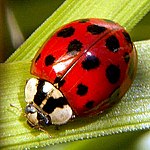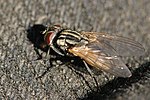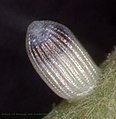Entomology/Print version
| This is the print version of Entomology You won't see this message or any elements not part of the book's content when you print or preview this page. |
The current, editable version of this book is available in Wikibooks, the open-content textbooks collection, at
https://en.wikibooks.org/wiki/Entomology
Introduction
Introduction
[edit | edit source]Entomology is the study of insects. Entomology Departments sometimes include scientists that study arachnids, but those are not insects. Insects are six-legged, which arachnids have 8 or more legs.
Insects and arachnids both belong to the Phylum Arthropoda, which also includes crustaceans (including shrimps and crabs), along with some other small groups. The Arthropoda are jointed leg animals with an exoskeleton. Entomology is concerned with the life history, biology, behavior, and ecology of insects. It is one of the few biological disciplines that includes study of both the organism in the environment and how to control them (e.g. agriculture).
What are insects?
Insects
[edit | edit source]Insects are animals with three body segments (the word insect means "segmented"): the head, the abdomen, and the thorax. Insects have, typically, three pairs of legs located on the abdomen; however, there are exceptions, such as brush-footed butterflies.
Insects belong to the taxonomic class Insecta, which is just one class of Phylum Arthropoda. The arthropods also includes Crustacea (crabs, lobsters, etc.), Arachnida (spiders, mites, etc.), and Myriapoda (Centipedes and Millipedes). The class Insecta is closely related to the class Entognatha (Collembola, Diplura, and Protura), which is usually included in the study of entomology. Both Insecta and Entognatha are within the subphylum Hexapoda.
Insects have a wide range of life cycles, but there are some basic similarities. They almost all begin as eggs, which vary widely in shape and size. Then insects undergo a period of growth. Some then undergo a metamorphosis ("huge change"), into an adult form.
Insects such as silverfish (order Zygentoma) do not undergo metamorphosis at all — they grow directly from hatching to their full size, and molt several times as a mature adult.
Some Insects, such as true bugs (order Hemiptera) and grasshoppers (order Orthoptera), undergo an incomplete metamorphosis. When they hatch from eggs they are called nymphs. These nymphs will eventually grow into their final adult form. They do not molt after that.
Insects such as butterflies, moths, and flies undergo a complete metamorphosis. When they hatch from eggs, they are called larvae. Once they have grown through several periods called instars, they become pupae (in butterflies it's called a chrysalis). Eventually, an adult, or imago phase, will emerge from the pupa.
Insects are very successful organisms. They exist in every type of terrestrial habitat, including some flies native to Antarctica. Insects also vary widely in shape, size, colour, etc. There are currently well over 900 thousand named species of insect, and estimates place the total number of species between 2 and 30 million.
Common insects
Introduction
[edit | edit source]There are about 27 orders of insects. With new genetic and other information, the arrangement and number of the orders has been changing and may continue to do so. In this brief guide, we're only going to cover a few of those more commonly important to humans.
In descending order of number of species, the orders of insects we will cover are:
- Coleoptera (Beetles, about 400,000 species)
- Lepidoptera (Butterflies and moths, about 150,000 species)
- Hymenoptera (Wasps, bees, and ants, about 130,000 species)
- Diptera (Flies, about 120,000 species)
- Hemiptera (true bugs, about 82,000 species)
- Orthoptera (Grasshopers, crickets, and mantids, about 20,500 species)
- Odonata (Dragonflies and damselflies, about 5,500 species)
Coleoptera
[edit | edit source]Coccinella septempunctata
[edit | edit source]
The seven-spotted ladybird (or ladybug) is a very common beetle found in both North America and Europe, and is an important predator of aphids.

Harmonia axyridis
[edit | edit source]
The Asian lady beetle (or harlequin ladybird) is a species that is similar to C septempunctata. This species is also an important predator of aphids, however is causes more problems to humans, because they freqently overwinter in homes. The species is originally from East Asia, but was introduced to North America and Europe.

Lepidoptera
[edit | edit source]Papilio
[edit | edit source]The genus Papilio includes many species that are well-known around the world. Such species are charchterised by their "swallowtails" for which they are named.
-
Papilio glaucus, Eastern Tiger Swallowtail
-
Papilio machaon, Old World Swallowtail
-
Papilio xuthus, Asian swallowtail
-
Papilio polyctor, Common Peacock
Danaus plexippus
[edit | edit source]
The Monarch butterfly is common in North America, as well as New Zealand and Australia. It is one of the few milkweed butterflies in North America. As larva, the monarch feeds on milkweed, which is poisonous. This poison persists in the monarch as an adult, which provides it protection from many predators. This is so successful, that Limenitis archippus (in the same family, but in a different subfamily) mimics the monarch so that it is not eaten by predators.
Hymenoptera
[edit | edit source]-
Vespula germanica
-
Apis mellifera
-
Iridomyrmex purpureus
Vespula
[edit | edit source]Yellowjackets are wasps that can be found in both Europe and North America. There are two particular species: Vespula germanica and Vespula vulgaris. These are known as the German wasp and the common wasp, respectively. Yellowjackets are social insects— a queen builds a nest, usually of wood, and then lays eggs. When the eggs hatch, the larvae are carnivorous, and feed on other insects. Adult wasps feed on nectar. Though, often considered pests or harmful to humans, wasps are important predators of many other pests such as flies.
Apis
[edit | edit source]Honeybees are important plant pollinators.
Diptera
[edit | edit source]Musca domestica
[edit | edit source]
The housefly is very common, and frequently lives with humans. Flies, like butterflies, undergo complete metamorphosis. In their larval stage they are called maggots, in which they will feed on organic matter. After three instars, they become pupae, then emerge as adults. Like other insects, the purpose of the adult form is for mating— flies live only about one month after maturation. Flies have sponging mouth-parts. They can only consume liquids, but can also apply digestive fluids to solids, and then ingest them as fluids.
Culicidae
[edit | edit source]Mosquitos are known particularly for spreading disease. Mosquitos, like other flies, undergo compete metamorphosis. Eggs, larvae, and pupae develop in water, but the adult is terrestrial. The larvae also develop in three instars. The pupae then float to the surface of the body of water, so that the adults can emerge into the air.
-
Culiseta longiareolata
-
Culex quinquefasciatus
-
Anopheles stephensi
Hemiptera
[edit | edit source]True bugs.
Orthoptera
[edit | edit source]Grasshopers, crickets, and mantids
Odonata
[edit | edit source]Dragonflies and Damselflies
Lepidoptera
Lepidoptera includes butterflies, moths, and skippers.
Development
[edit | edit source]Butterflies undergo complete metamorphosis, that includes four stages: egg, larva (caterpillar), pupa (chrysalis), and adult (imago).
Egg
[edit | edit source]Eggs are extremely varied among lepidopterans. Many species can be identified by their eggs. Eggs are generally laid on the host plants of lepidopterans, so that once hatched the larva will have a food supply.
Caterpillar
[edit | edit source]Like other larvae, the only purpose of this stage is growth. During this stage the caterpillar spends most of its time eating. In this stage, the caterpillar's anatomy is quite simple. Its eyes are very simple, only capable of determining light from dark. The caterpillar has 3 pairs of true legs located on its thorax, and 5 pairs of false legs called prolegs on its abdomen. Also, the digestive tract is particularly pronounced in this stage, making up most of the internal organs of the caterpillar. The appearance of caterpillars is also quite varied. Some are described as "worms," with only bare, plain-coloured bodies. Some are bare, but have more brightly coloured bodies. Others have hair or spines that have poisons that aid in self-defense.
Chrysalis
[edit | edit source]
After a number of growth periods, called instars, a caterpillar will find a spot, often a plant (other species may burrow into the ground), and forms a pupa. The lepidopteran may form something called a cremaster so that it remains attached to the plant it has chosen. The cremaster is made of silk. Species called silkmoths will spin a cocoon made of silk. The pupa of a lepidoptera is called a chrysalis. During this stage a process called histolysis occurs, in which the organs of the caterpillar "dissolve" and reform in a process called histogenesis. Many species overwinter in this form.
Imago
[edit | edit source]
Other insects
Introduction
[edit | edit source]There are many kinds of insects that are not commonly seen in different parts of the world. Use the free Rove Pest Prediction Tool to see a basic display of which insects can be found throughout the U.S. during different months of the year.
Other Insects
[edit | edit source]This is an alphabetical list of currently recognized orders of insects.
- Order: Blattodea - Cockroaches and termites
- Order: Coleoptera - Beetles
- Order: Dermaptera - Earwigs
- Order: Diptera - Flies
- Order: Embioptera - Web-spinners
- Order: Ephemeroptera - Mayflies
- Order: Hemiptera - True Bugs
- Order: Hymenoptera - Bees, Wasps and Ants
- Order: Lepidoptera - Butterflies and Moths
- Order: Mantodea - Praying Mantids
- Order: Mecoptera - Scorpionflies
- Order: Megaloptera - Alderflies, Dobsonflies & Fishflies
- Order: Microcoryphia - Archaeognatha
- Order: Neuroptera - Lacewings, Antlions & Mantidflies
- Order: Odonata - Dragonflies and Damselflies
- Order: Orthoptera - Grasshoppers and Crickets
- Order: Phasmatodea - Stick insects and Leaf insects
- Order: Phthiraptera - Biting and Sucking lice
- Order: Plecoptera - Stoneflies
- Order: Psocoptera - Booklice and Barklice
- Order: Raphidioptera - Snakeflies
- Order: Siphonaptera - Fleas
- Order: Strepsiptera - Strepsipterans
- Order: Thysanoptera - Thrips
- Order: Thysanura - Three-pronged bristletails
- Order: Trichoptera - Caddisflies
- Order: Zoraptera - Zorapterans
What are arachnids?
Introduction
[edit | edit source]Arachnids are commonly mistaken for insects. The group includes spiders, scorpions, ticks and sun-spiders (which are not real spiders).
Common arachnids
Introduction
[edit | edit source]- Spiders
- black widows
- recluse spiders
- tarantulas
- jumping spiders
- Scorpions
- giant hairy desert scorpion
- emperor scorpion
- Ticks
Other arachnids
Introduction
[edit | edit source]- less common spiders
- less common scorpions
- whip-scorpions
- sun-spiders
- seed ticks























